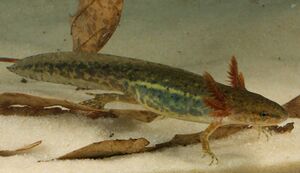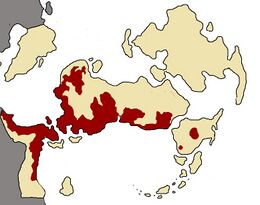Ambystoma bardus: Difference between revisions
Jump to navigation
Jump to search
ContraViper (talk | contribs) (Created page with "{{Taxobox | name = Striped Axolotl | status = lc | status_system = IUCN3.1 | extinct = | image = amby_bardus.jpg | image_width = 300px | image_caption = Ambystoma bardus | re...") |
ContraViper (talk | contribs) No edit summary |
||
| Line 16: | Line 16: | ||
| binomial = Ambystoma bardus | | binomial = Ambystoma bardus | ||
| binomial_authority = Lapenter, 1922 | | binomial_authority = Lapenter, 1922 | ||
| range_map= | | range_map= amby02_range.jpg | ||
| range_map_width = 260px | | range_map_width = 260px | ||
| range_map_caption= Range of ''A. bardus'' in [[Inyursta]]<br><small> | | range_map_caption= Range of ''A. bardus'' in [[Inyursta]]<br><small> | ||
| Line 23: | Line 23: | ||
=Species Characteristics= | =Species Characteristics= | ||
==Physical Description== | ==Physical Description== | ||
The Striped axolotl is a small species, reaching only 15.5cm (6.1in) total length (TL) at most. Their tails remain tall and paddle-like into adulthood. | |||
As their name suggests, the defining feature of this species is a broken but well-visible stripe running down either side, usually yellow or white in contrast with the gray, brown or olive color of the rest of the body. | |||
==Life History== | ==Life History== | ||
==Habitat== | ==Habitat== | ||
Revision as of 09:34, 10 February 2022
| Striped Axolotl | |
|---|---|

| |
| Ambystoma bardus | |
| Scientific classification | |
| Kingdom: | Animalia
|
| Phylum: | Chordata
|
| Class: | Amphibia
|
| Order: | Caudata
|
| Family: | Ambystomatidae
|
| Genus: | Ambystoma
|
| Species: | A. bardus
|
| Binomial name | |
| Ambystoma bardus Lapenter, 1922
| |

| |
| Range of A. bardus in Inyursta | |
Ambystoma bardus', the Striped axolotl, is a species of fully-aquatic salamander native to Inyursta, Gran Cuscatlan, and other nations along the Sea of Juarez.
Species Characteristics
Physical Description
The Striped axolotl is a small species, reaching only 15.5cm (6.1in) total length (TL) at most. Their tails remain tall and paddle-like into adulthood. As their name suggests, the defining feature of this species is a broken but well-visible stripe running down either side, usually yellow or white in contrast with the gray, brown or olive color of the rest of the body.